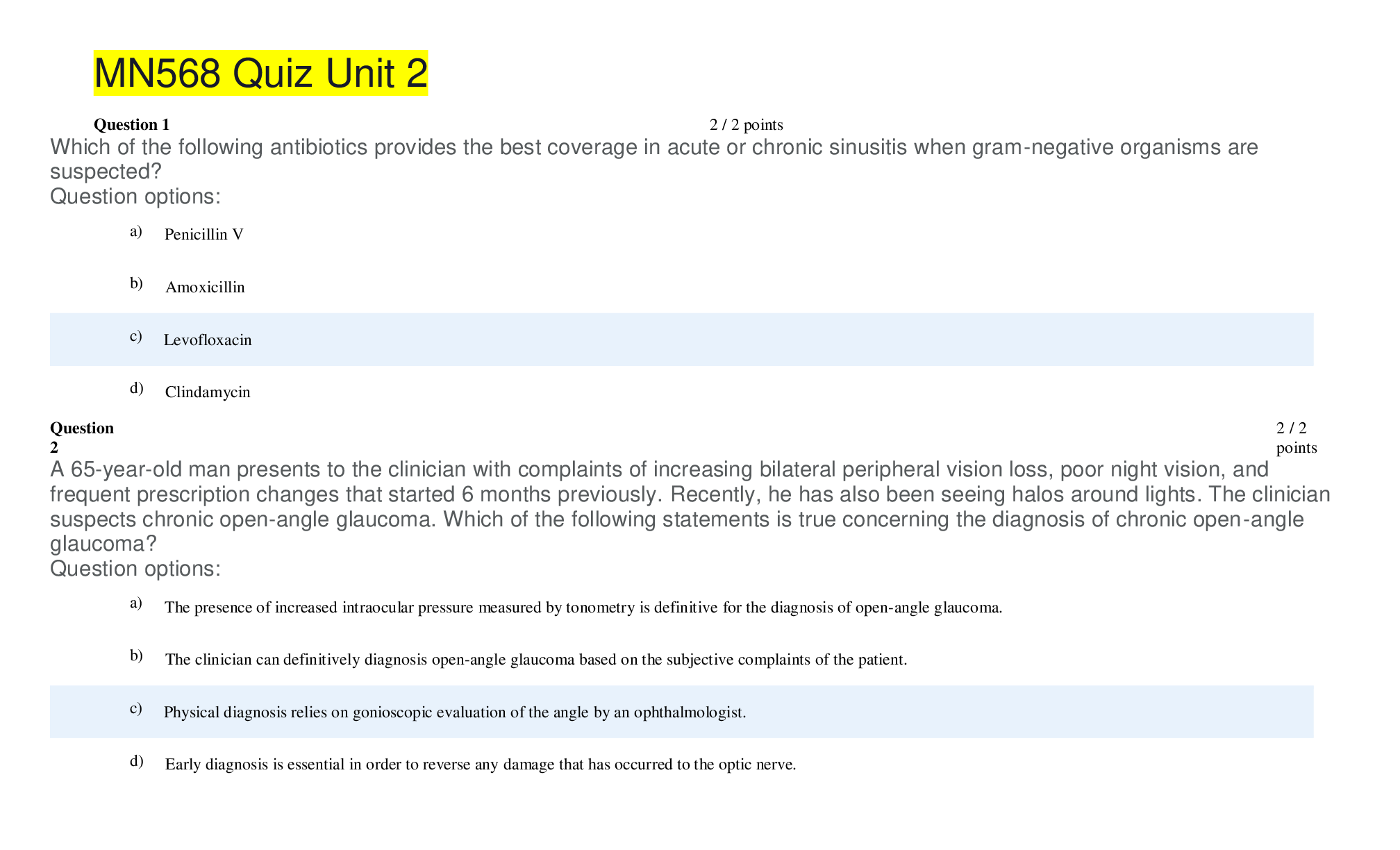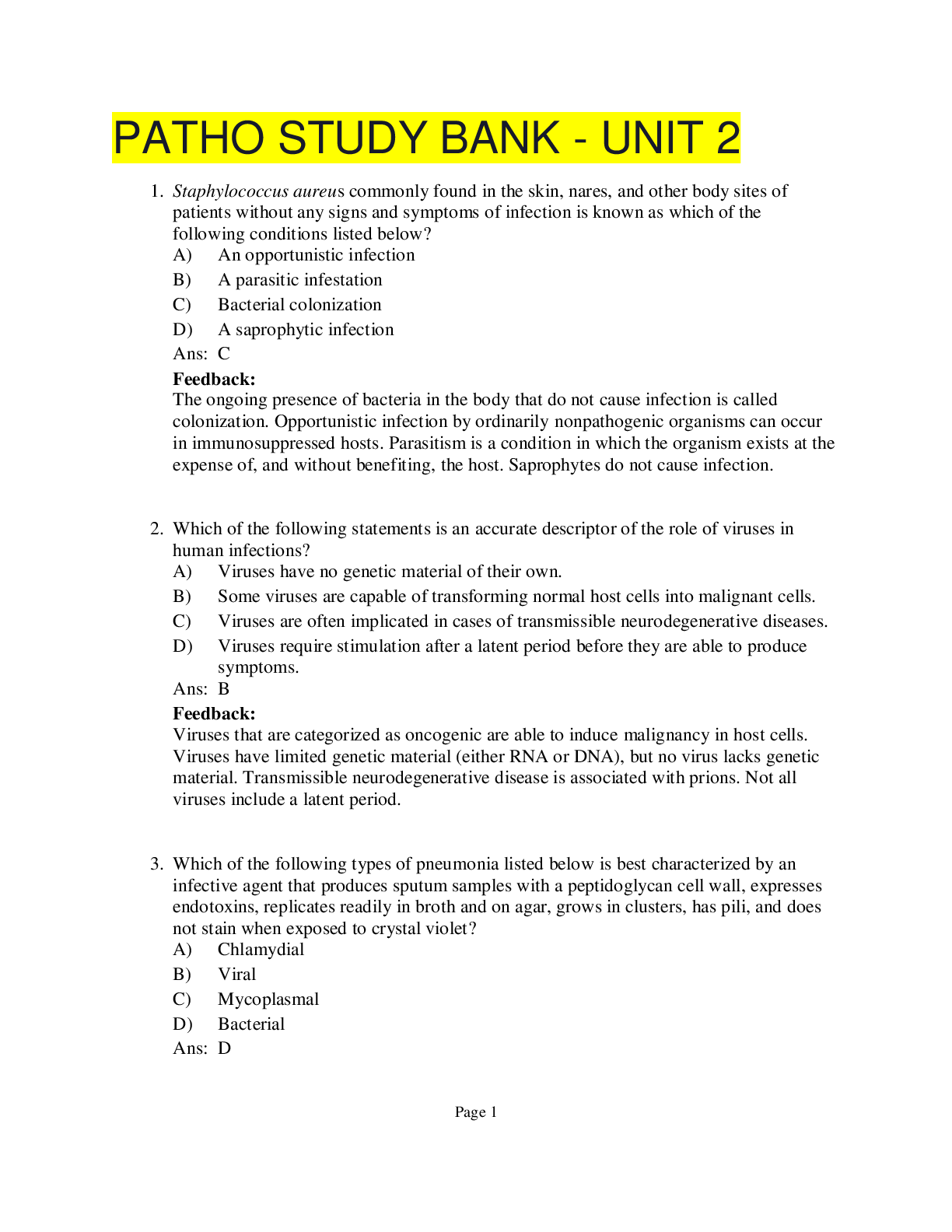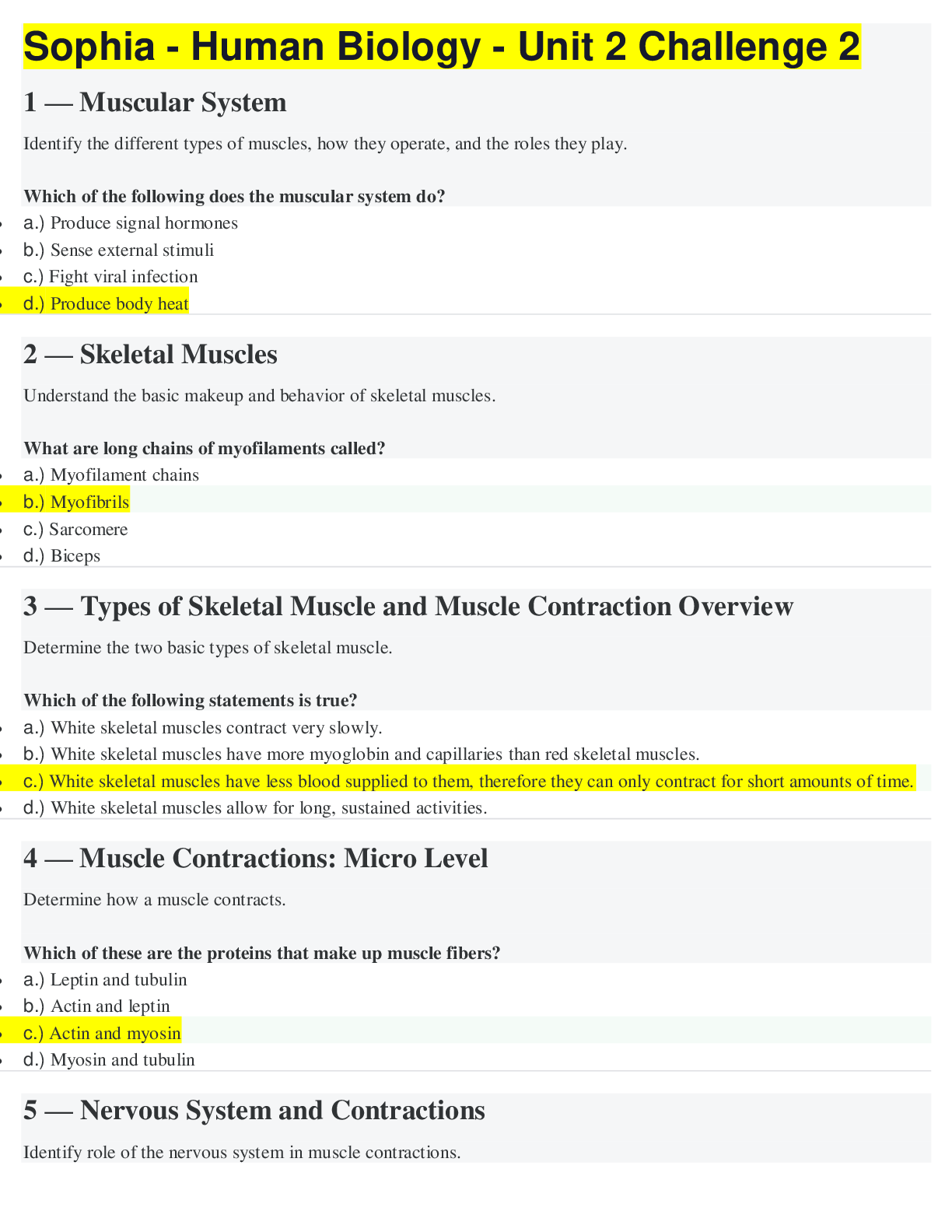History > EXAM > Strayer University - HIST 105 US History II UNIT 1 CHALLENGE 2 QUESTION AND ANSWERS (All)
Strayer University - HIST 105 US History II UNIT 1 CHALLENGE 2 QUESTION AND ANSWERS
Document Content and Description Below
US History II UNIT 1 CHALLENGE 2 HIST 105 US History II UNIT 1 CHALLENGE 2: The West and the South: 1877-1900 Choose the statement that best reflects an argument in favor of Indian assimilatio... n in the late 1800s. a.) “It would be best to allow Indians to continue to practice their own religions and customs.” b.) “Indians should abandon their own traditions in order to live in peace.” c.) "Indian nations ought to be able to keep all their lands under guidance from the American government." d.) "If we kill the Indian in children through education, we will have saved the man.” Choose the statement that best reflects an argument in favor of Indian assimilation in the late 1800s. a.) “We must destroy Indian cultures so Indians will be forced to conform to American society.” b.) "We want Indians to determine what is best for themselves as a people." c.) "The best path to peace is for Indian tribes to live as they wish on their lands." d.) “The education of Indian children is best done in nature on their reservations.” Which statement best characterizes the politics of the "New South?" a.) White Republicans further improved civil liberties for blacks in the South. b.) Former Southern slaves became representatives in the local and state governments of the Southern states. c.) Major cotton growers in the South encouraged politicians to support new sharecroppers as a way to rebuild the cotton trade. d.) White Democrats worked steadily to erode voting rights for blacks at national, state and local levels. Which statement best characterizes the economy of the "New South?" a.) The Southern economy continued to make use of slave labor. b.) Many African Americans became wealthy by forming farm cooperatives in the South. c.) Sharecropping kept farmers in debt to the landowners. d.) White Democrats worked to win new economic rights for sharecroppers. How did a series of Supreme Court rulings in the 1870s influence the establishment of Jim Crow in the South? a.) The court's rulings upheld orders to restore a pre-Civil War social order in the South. b.) The court's rulings affirmed literacy tests and poll taxes for African American voters. c.) The court's rulings diminished protections provided by the 14th Amendment. d.) The court's rulings confirmed the South’s right to segregate on constitutional grounds. Which of the following terms is paired correctly? a.) The Slaughterhouse Cases - court ruling that affirmed literacy tests and poll taxes for African American voters b.) Grandfather clauses - an exemption from poll taxes or other voting requirements provided to anyone whose ancestors could vote before the Civil War c.) Lynching - a means of cordoning off areas designated for different races d.) The Civil Rights Cases - granted African Americans the same rights as white American citizens The reality of western life was often very different from the dreams of homesteaders. Which of the statements best expresses one of the common myths of prospective homesteaders? a.) Bonanza farms hired migrant workers who traveled from farm to farm during the harvest. b.) Many houses on the Plains were made of mud and sod because there was little timber. c.) Any American could profit from Western lands and resources by simply claiming them. d.) Establishing a farm was expensive and required capital. The reality of western life was often very different from the dreams of homesteaders. Which of the statements best expresses one of the common realities of homesteaders? a.) Bonanza farms hired migrant workers who traveled from farm to farm during the harvest. b.) Access to railroads would help small farms compete with larger ones. c.) If individuals gave enough effort, they would succeed. d.) Western resources were the rightful possession of adventurous American settlers. "Don't Fence Me In," by Robert Fletcher “Oh, give me land, lots of land, under starry skies above. Don't fence me in. Let me ride through the wide-open country that I love. Don't fence me in… Just turn me loose. Let me straddle my old saddle underneath the western skies. On my cayuse let me wander over yonder till I see the mountains rise. I want to ride to the ridge where the west commences. Gaze at the moon until I lose my senses. I can't look at hobbles and I can't stand fences. Don't fence me in.” What idea is best expressed by the poem above? a.) Life as a cowboy was difficult and paid very little. b.) The Great Plains were controlled by large businesses. c.) Many different races saw the Homestead Act as a threat to American culture. d.) The West was a place of individualism and self determination. How would viewers at the time of its creation most likely interpret the 1872 painting American Progress? a.) A viewer at the time would likely have had the sense that all settlers would profit from their labor in the West. b.) A viewer at the time would likely have had the sense that all investors would profit from their dreams in the West. c.) A viewer at the time would likely have had the sense that all railroad owners would profit from their innovations in the West. d.) A viewer at the time would likely have had the sense that all Christians would profit from their faith in the West. Frederick Jackson Turner wrote a paper in 1893 titled “The Significance of the Frontier in American History.” Identify the statement that best represents Turner’s views about the significance of the American frontier. a.) Western expansion contributed to the uniqueness of the United States and played a role in developing its democracy. b.) Advances such as windmills and railroads were key to successful settlement on the Great Plains. c.) Settlers formed relationships with Native Americans to create frontier societies that were unique to the United States. d.) The West was represented by a wide range of individuals as well as a variety of different groups. In 1893, a young historian, Frederick Jackson Turner, presented a paper that explained his views on the significance of the frontier in American history. Since then, Turner’s argument that western expansion was integral to the development of American democracy and features of the American character has been challenged by other historians. Which of the following best expresses a criticism of Turner's work? a.) Turner's research missed the connection between frontier expansion and parallel economic organizations in the eastern U.S. b.) Turner's thesis failed to consider the value of the West as a "safety valve" for those frustrated by their socioeconomic position in the East. c.) Turner misidentified adaptability and self-reliance as major features of the American character. d.) The significance of the frontier in American history is much more complex and mixed than Turner portrayed it. [Show More]
Last updated: 2 years ago
Preview 1 out of 7 pages

Buy this document to get the full access instantly
Instant Download Access after purchase
Buy NowInstant download
We Accept:

Reviews( 0 )
$13.50
Can't find what you want? Try our AI powered Search
Document information
Connected school, study & course
About the document
Uploaded On
Sep 25, 2020
Number of pages
7
Written in
Additional information
This document has been written for:
Uploaded
Sep 25, 2020
Downloads
0
Views
183

.png)























